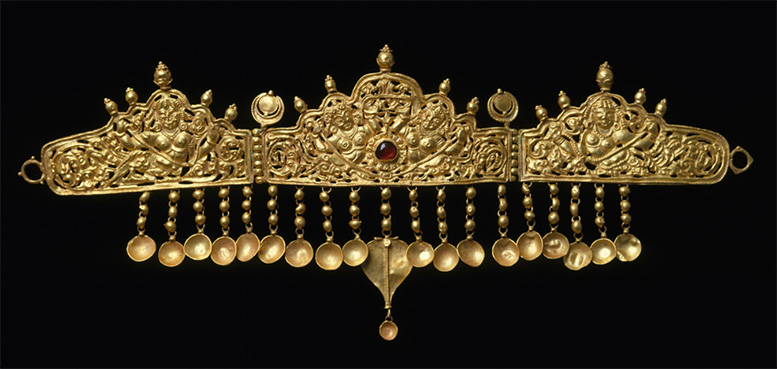
By Jeff Paul
In November of last year, India banned certain cash notes in a bold move to force businesses into the banking system to better harvest more taxes from its livestock. Now, under the guise of “improving transparency” and forming a “common market,” India has begun targeting gold with new taxes, regulation, and incentives for citizens to turn over their undeclared gold to the financial sector.
Roughly 86% of India’s economic activity happened in cash at the time much of it was banned. Presumably that includes the $19-billion-per-year retail gold industry. Again, it appears that India’s government (central bankers) wants a bigger cut of the action and to better track the private assets of citizens.
Bloomberg has been reporting that India’s government is teaming up with crony gold dealers to plan a complete revamp of its gold policy – which is always code for “control, regulate and tax.”
Bloomberg reports:
India, which vies with China as the top consumer of bullion, is working on new policies to improve transparency and help expand its $19 billion gold jewelry industry, according to people with knowledge of the matter.
The plans being worked out by the finance and commerce ministries along with industry groups should be finalized by the end of March, the people said, asking not to be identified because they aren’t authorized to speak publicly….
The start of a spot bullion exchange, to make gold supply more transparent and help enforce purity standards, is under consideration, the people said. An import tax of 10 percent could also be reduced as the government seeks to eliminate smuggling, they said. The plans also include a dedicated bank for the jewelry industry, according to one of the people.
The overhaul of India’s disorganized and fragmented gold jewelry industry is meant to bolster confidence among consumers, where the gifting of gold at weddings and festivals or its purchase as a store of value are deeply held traditions. Ensuring quality standards and allowing supply chains to be easily tracked are ways to enhance trust.
In addition to a 10% import tax on gold, which authorities admit causes smuggling, India recently placed a 3% nationwide goods and services tax on gold that goes into effect on July 1st. Grateful slaves celebrated the event as a “lower than expected rate” and as creating a “common market,” Bloomberg reported when the tax passed:
India fixed the duty at 3 percent over the weekend, lower than the 5 percent expected, Ketan Shroff, joint secretary at the India Bullion and Jewellers Association Ltd., said Monday. The goods and services tax, to be implemented from July 1, will replace more than a dozen domestic levies including excise tax and state tariffs, drawing India for the first time into a common market.
ProTip to wannabe dictators: If you’re a tyrant who wants to centralize power over an industry, first frighten large businesses into your cartel protection racket. Then, eliminate local sovereignty over markets while imposing your own regulations and taxes. But call it “drawing into a common market” and “improving transparency to protect them.” Works every time. The final step is to prosecute non-compliance using men with guns.
The creation of a spot market and special bank for gold jewelers (as rumored above) seems like a function that doesn’t require government at all. Yet if your goal was to track, trace and database your citizens’ undeclared gold assets, it makes perfect sense.
Bloomberg makes clear that the new policies aim to encourage citizens to turn over their “idle gold” to the financial system:
The government is also keen to get the public to recycle its jewelry to reduce the nation’s reliance on imports. After a slow start to its plans to monetize the precious metal held in households and institutions, the government is looking to tweak the scheme and attract more participants, the people said, without giving details. The initiative, launched in November 2015, was aimed at returning an estimated 20,000 metric tons of idle gold to the financial system.
It’s reminiscent, albeit a softer version, of Franklin D. Roosevelt’s Executive Order 6102 “forbidding the Hoarding of gold coin, gold bullion, and gold certificates within the continental United States” which criminalized the possession of monetary gold. Citizens were forced to turn over their gold for a set amount of government currency. We’ll have to wait and see how India “tweaks the scheme.”
Credit Suisse confirmed the latest moves in India are designed to force the gold trade onto the banking system in partnership with the central government to better track and tax the industry.
Credit Suisse Group AG told Bloomberg “the (gold) sector will find it tougher to evade taxes as legal imports go through the banking system, and a full trail will now be established by the new nationwide tax compared with previous duties which were levied at the state level only.”
This echoes what Credit Suisse Group AG analysts Arnab Mitra and Rohit Kadam previously said of the coming changes to the Indian gold industry: “Over the next two to three years, the new tax should gradually force smaller, unregulated players to become tax compliant and take away their price advantage, increasing market share for bigger, organized businesses.
There you have it. The cashless agenda of control laid bare. There shall be no economic activity outside of State control. Cartels that play nice will be rewarded with more market share.
It remains to be seen if an already angry Indian citizenry can be persuaded to gift up their tradition of storing and gifting gold.
Jeff Paul writes for Activist Post and Counter Markets newsletter. This article is Creative Commons. You may republish in full with attribution and link to this post.
Source Article from http://feedproxy.google.com/~r/ActivistPost/~3/y4ldy8pRRhQ/first-india-bans-cash-now-begins-regulating-new-gold-tax.html
Related posts:
Views: 0
 RSS Feed
RSS Feed

















 June 25th, 2017
June 25th, 2017  Awake Goy
Awake Goy 





 Posted in
Posted in  Tags:
Tags: 
















